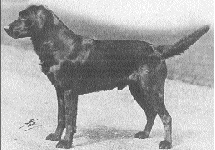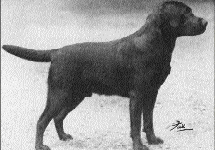| Margaret D. Heaney Derby, NY I was delighted to see your question, "What Do You Think?" regarding Labrador Retrievers. The two pictures of the old Labs certainly bespeak what the standard says and what Labradors should resemble. I had a difficult time keeping my comments (enclosed) down to 400 words. I have so much I want to say. As a Labrador devotee for more that 40 years I have seen some very disturbing changes in the breed --not only conformation but temperament as well. We have seen many fanciers get involved in the breed and have heard the comment too frequently that "I want to develop my own style of Lab." This is highly frustrating to me and to many others who have simply seceded from breeding and exhititing because they can't beat the advertisers and the "heavy" breeders. "Those who produce and exhibit in great numbers are the ones who come out ahead," as far as ribbons and championships are concerned. As far as the quality of the breed, I am less convinced. My dad bought his first Lab, of the Arden lines, in the early fifties. I read the Labrador Retriever standard for the first time shortly therafter when I was about eight years old. Although there have been some verbal changes, the essence of the standard has not changed. The purpose of the dog has not changed and the desire for such a dog--temperament, stability, and the simple elegant beauty of the dog--should not have changed either. However, looking at the broad spectrum, what is available is too diverse. There was once a dog that was a bit bigger and rangier that might have been considered the field type, and more compact, slightly heavier dog that was considered the bench dog. Today we have the weedy, the all-breed, the specialty Lab, the English, the American type, and once in a while one that truly fits the standard. I will look forward to the responses that you receive. They will probably be as numerous as the types of Labs we see today. There should be room for differences, as the wording in most American breed standards is certainly ambiguous in the eyes of some. However, I know the standard and the breed as well as the purpose for which they were developed. Picture yourself trying to pull the short-legged, heavily-boned, overweight Lab of today's show ring into a boat after a retrieve. Picture further that same Lab on a hot October morning, in thick cover, lasting for a full day of upland game hunting. Neither, in my eye, is a pretty picture. May I say, also, that I truly enjoy your magazine. I look forward to the articles each month, especially those by Rick Beauchamp, Annie Clark and Tatler. In my opinion Dogs In Review offers more for the dog person than does the AKC Gazette. Thank you, both for the magazine and for the opportunity to respond to your "History Lessons." Comments on the two photographs: The "top winners," Dogs A and B, are worthy of serious consideration. In today's show rings, I believe both would be ignored as being the "odd man out." canceling success. These dogs are not heavy enough for today's competition, have too much leg, appearing to tall, and of too moderate bone. Their tails don't appear to be "clubs." Coats on both look to be of the proper length and density, not open. They are not overangulated nor overweight. Dog A;s head has the proper planes, length and proportion. Although one is unable to see his expression, this leads me to believe a kind, soft and intelligent expression is present. Dog A's topline is correct; that is, not sloping, but with a slight dip behind the withers (necessary for all swimming dogs). When looking at Dog B, from the angle of his picture, he may have a shorter hock than Dog A, but his head does not seem to have as correct planes, nor as correct proportion, as Dog A. Dog B also appears to have a more sloping topline and appears to be missing the dip behind the withers. Dogs A and B have much to offer the breed today. Proper bone and coat length, strong pasterns, proper feet and correct shape and set of tail. The forechests are not overly "pigeoned" and of the correct depth - reaching to the elbows. Each underline is also correct, nearly level, not too tucked up, nor too low. Both have lovely length of neck and proper ear set. Comparing these to those in the ring today points up the huge, negative and significant changes of the last 20-25 years. The breed today no more compares to the AKC standard for Labs than does a Corgi. The heads of today's dogs are too short-muzzled, skulls to broad, leading to a "mean" expression or a head style reminiscent of other breeds. Body and bone, also, have become so thick that, at a distance in a dark room, they might be mistaken for a Rottweiler with a tail. Height is often below standard. Movement has become plodding and thumping as opposed to the easy, tireless and effortless movement necessary for a good upland game hunter. I have had Labradors since 1953, participating in many aspects of the sport of dogs including field trials, obedience, the Breed ring, breeding, and as a professional handler of all breeds since the '70s. I love Labradors. |
 |
 |
| October 2000 issue |
| Let Margaret know you like her article |

|
| have read this article |